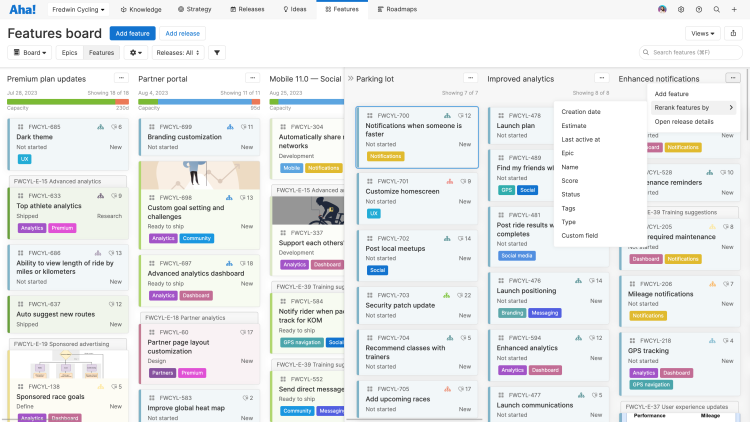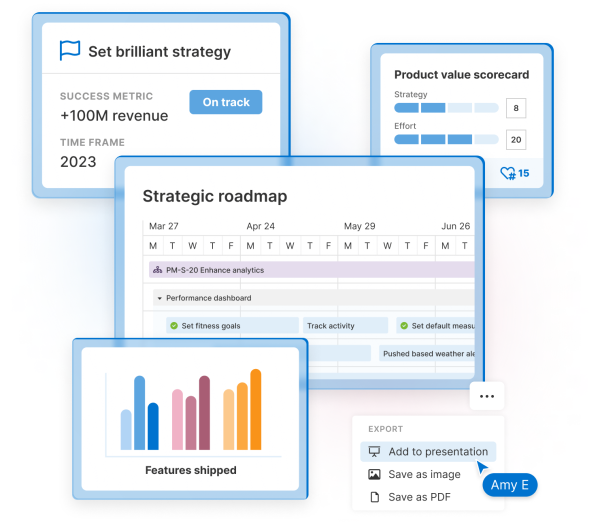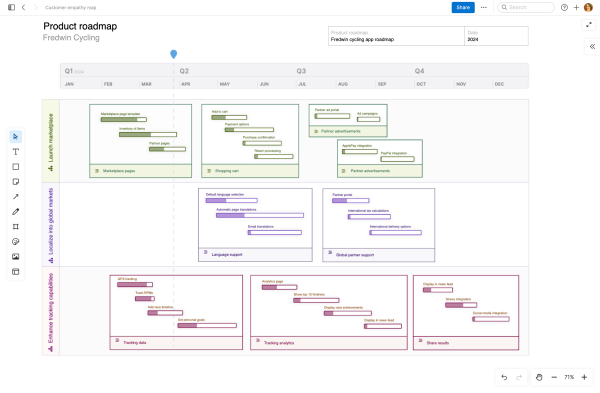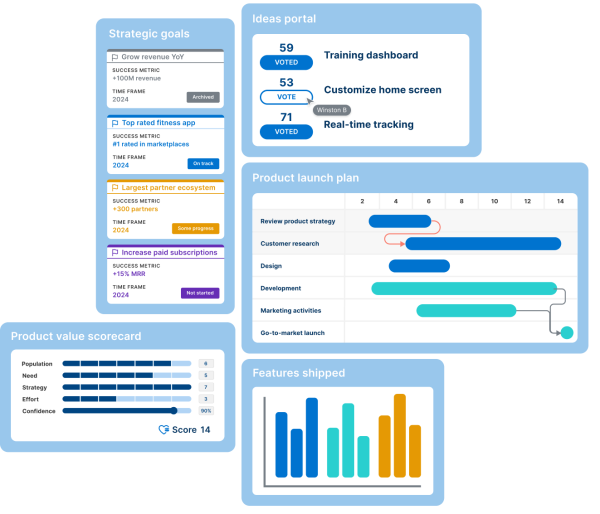What is a product backlog?
Last updated: February 2024
A product backlog is a prioritized inventory of new features and other enhancements. It should contain work that you have identified as valuable to implement, but have not yet added to a release. Essentially, a product backlog functions as a queue for upcoming product updates.
You will always have more to do than what can fit on your product roadmap. So you need a place to keep this work before it is ready to build. This is your product backlog. As you plan new releases, you will decide what to work on by moving items from your backlog to the roadmap — typically starting at the top of the list, where your most valuable features should live.
Manage your product backlog in Aha! Roadmaps — try it for free.
Deciding what belongs in the product backlog (and how it gets prioritized) is typically part of a product manager's job. These decisions depend on a variety of factors — including internal feedback, customer requests, and effort to build. But the most important criterion is strategic alignment. Mapping backlog items to your product strategy ensures that the product team is consistently working toward measurable goals.
It takes effort to effectively manage and refine a product backlog. But with the right processes and tools in place, it can become a streamlined piece of your product development process. In this guide, we will walk through the fundamentals of optimizing your product backlog. Use the following links to jump ahead to a specific section:
Product backlog best practices
Building an effective product backlog takes a thoughtful approach. Done well, it can become a useful tool for staying organized and focused on the work that matters most. Before we dive into the details of what a product backlog entails, let's talk through some best practices.
Your product backlog should be:
Strategic: If an item of work does not support your product goals and initiatives, it probably does not belong in the product backlog. Backlog features should already be vetted against your strategy and agreed upon as a priority by the product team. This ensures that any work moving from the backlog to your roadmap will drive impactful progress.
Comprehensive: New product features and enhancements make up the core of your backlog. But it can also include technical training for your team, re-factoring or re-architecture efforts, bug fixes, and other non-feature projects that might better position you for product success.
Selective: Your product backlog is not a catchall place to store ideas for later. Be purposeful in which items you add, and how many — overloading the backlog with dozens of features can make it unwieldy to rank and sort. Try to limit your backlog to a manageable number of items that you can review week to week.
Navigable: Most product backlogs are organized into vertical lists with the highest-priority items at the top. That way, you can quickly see what is coming next. Use tags, categories, and scores to see more details at a glance — so you can move faster when planning releases.
Although your product backlog represents a queue of upcoming work, it is worth mentioning that not every item in your backlog belongs on the roadmap. Remember that your roadmap is a tool for strategic communication — you use it to convey the most impactful updates to your audience. Items such as technical debt and bug fixes, for example, do not need to be displayed here.
Related:
How to set up a product backlog
It can be simple to start creating a product backlog — even if you have never built one before. The items that make up your backlog require a lot of research, ideation, and collaboration to define, but the backlog itself is simply an ordered list.
If you are getting set up for the first time, here are the basic steps for building a product backlog:
Gather the most important features, enhancements, and fixes that your team is planning to work on. Make sure each one is well defined and ready to go with requirements, estimates, and other necessary details.
Select a tool or whiteboard template to house your product backlog — preferably one that allows for multiple columns, such as a kanban-style board. Choose a column to represent the backlog.
Populate the backlog column with the features you gathered in a vertical list.
Add categories, tags, and other visual indicators to each feature.
Rank backlog items in priority order — starting with the most valuable features at the top. Be sure to run these decisions by the cross-functional product team, which will have important context and feedback on what should get prioritized.
Get to work! As you plan releases, pull items of work out of your backlog and into your release plan. If you are using a kanban-style flow, you will likely place it in the next column to the right of the backlog.
Keep managing the backlog. (Jump to the next section for tips on how.)
Below is a product backlog example in Aha! software. Product backlog (or Parking lot) items are kept in a column that expands in a drawer view. In addition to the primary backlog, you can see categories grouping features related to "Improved analytics" and "Enhanced notifications." There are also options for ranking backlog items by value score, tags, and other options in the dropdown menu. As work progresses, you can click and drag Parking lot items directly into a release on the Features board.
Who owns the product backlog?
In many cases, the product manager is accountable for the product backlog. They decide what belongs on the priority list in order to deliver the most value with each release. But if you have a product owner on your team, it is likely they will be responsible for the backlog instead (with close support from the product manager). This is more common among organizations that practice scrum.
Even though product backlogs (as well as sprint backlogs) are commonly associated with scrum, it is worth noting that anyone can (and should) use a product backlog to organize upcoming work — regardless of which methodologies you follow. This is how we treat our own product backlog at Aha! and it is how we are approaching the advice we share in this guide.
Related:
How to manage a product backlog
A product backlog is never "done" — it is a shared asset that plays an ongoing role in your release planning process. It is up to you to actively refine and prioritize what is in the backlog, ensuring that the work captured there does not become outdated over time. This is why many product teams establish set processes for backlog refinement.
For a deep dive into this topic, consider reading our guide on backlog refinement. If you want to get started quickly, though, here are a few tips for managing your product backlog:
Gather feedback: As you gather new insights from stakeholders, customers, and supporting teams, use that information to inform what belongs in the backlog — and what should be at the top of the list.
Say "no": Requests for new features and fixes can stream in from anywhere. To keep your backlog manageable, you will need to triage features that are less impactful or out of sync with your vision. You can always reevaluate them in the future.
Keep it fresh: Over time, features that were once a priority could become obsolete. This can happen when your goals shift or you adopt new technologies into your product. Make a habit of clearing out features that are no longer relevant.
Categorize: Your backlog does not have to be a single column — you can use multiple lists to group backlog items by category, initiative, or other themes. If you use product development software, you can also add tags to visually denote types of work.
Prioritize: Rank and sort items by priority so it is easy to see the most impactful items at a glance. This can help you plan new releases more efficiently. Refresh regularly as priorities evolve.
Add details: Ideally, any work items in your backlog should be ready to be pulled into a release at any time. That means all requirements, effort estimates, acceptance criteria, and other feature details should be filled out and kept current for all items in the backlog.
Set up backlog refinement meetings: Establish a feedback loop by scheduling regular backlog refinement meetings. These sessions act as a forcing factor for reviewing the backlog. Bring the product team together to go over the contents and align on what belongs, what does not, and what updates should be made.
Refine your backlog with this template in Aha! software — try it for free.
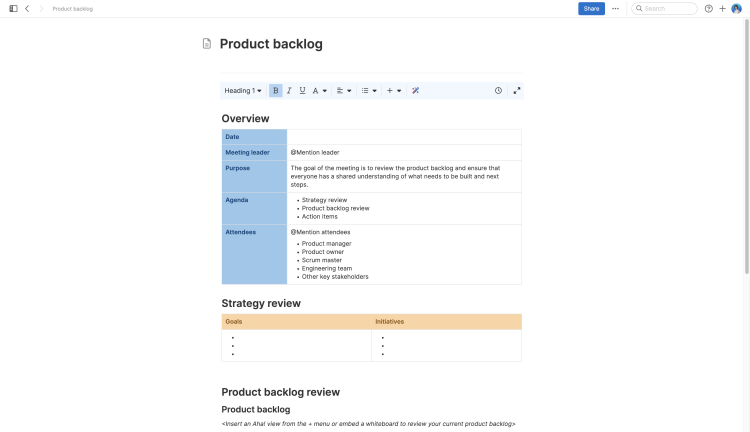
Moving work from your backlog to your roadmap
Remember that keeping a product backlog is just one step in the product planning process. From here, you will start to pull items from your backlog into releases and onto your roadmap. Your development team will get to work building the features you have prioritized. After launching, your product backlog will fill up again — and the cycle continues.
It takes some serious coordination to move work smoothly throughout product development. And it helps if you have the right tools. With Aha! Roadmaps, you can define detailed feature requirements with the help of an AI assistant, quickly build, rank, and sort your product backlog, and set priority limits for what you can achieve within a release. Then, it only takes a few clicks to go from backlog to roadmap and bring your product strategy to life — all within the same tool. Try it for free.
Editor's note: Although the GIF below still shows core functionality within Aha! software, some of the interface might be out of date. View our knowledge base for the most updated insights into Aha! software.
FAQs about product backlogs
When is a product backlog item considered complete?
If an item is in your product backlog, it is considered "not started." Product backlog items are considered complete only when you have pulled them into a release, built, and shipped them.
What are the key differences between a product backlog and a to-do list?
In a sense, a product backlog could be described as a complex to-do list of product work that you plan to complete. The key difference is that basic to-do lists are comprised of individual tasks. But product backlog items typically include far more than that — involving various requirements, contributors, and phases of work in order to complete.
How often should a product backlog be updated?
Aim to update your product backlog on a regular basis — weekly, monthly, or once per sprint, depending on how often your team meets. Backlog refinement sessions are a particularly good time to update the backlog.
How can you involve stakeholders in the product backlog prioritization process?
Backlog refinement sessions are the best way to involve stakeholders in prioritization decisions. These meetings bring cross-functional team members together to review and update what is in the backlog on a recurring basis. Using a template can help you cover strategy and get input from everyone present.
How does the product backlog relate to sprint planning?
During sprint planning, agile teams decide which items to pull from the product backlog into the sprint backlog. Whereas the product backlog functions as a broad inventory of upcoming work, the sprint backlog represents all of the work you plan to complete within a single sprint.
How can you ensure the product backlog reflects the most current business goals?
Regularly reviewing your product backlog can help you determine what is still aligned with your business goals and what is not. With Aha! Roadmaps, you can even link each backlog item to specific goals and initiatives — so you can clearly see how each feature rolls up to your overall strategy.
